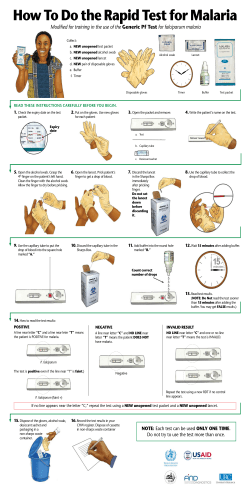
Target malaria elimination intervention in China using spatial
Target malaria elimination intervention in China using spatialtemporal distribution analysis Zhou Shuisen National Institute of Parasitic Disease, China CDC Content • • • • • Background Objectives Method Results Conclusion Background China Malaria Elimination Action Plan (2010-2020) Launched in 2010 • Target: • By 2015, local transmission of malaria should be eliminated except for partial border areas in Yunnan. • By 2020, malaria elimination should be achieved nationally. Background ((Cont.)) Categories Classification No. Target Pop. (10,000) Type I local infections are detected in 3 consecutive years and the incident rate equals or higher than 1/10,000 75 3965 Type II local infections are detected in 3 consecutive years, and the incident rate is lower than 1/10,000 at least in one of those 3 years 687 44792 Type III no local infections reported in 3 years 1432 62281 Type IV Non-malaria-epidemic-area 664 18882 Objectives • To map malaria incidence by parasite species over the last decade (2002-2010) over the entire country at county level spatial resolution using GIS; • To provide the scientific evidence for target interventions at malaria elimination stage. Method • Established the database of Annual Parasite Index records with detailed information about cases, malaria species, diagnostic used and origin of infection from 2002—2010 • Data collection and data source System ① Case Detection & Notification • • • Diagnosis Report Treatment • • Lab Confirmed Case Classification • Focus assessment Epidemiological Entomological • Targeted Action RACD Vector Control Health Education Hospital ③ Case Investigation & Classification County CDC ⑦ Focus Investigation & Action County CDC Method (Cont.) • Mapping and spatial analysis – Integrate the geographic data and malaria data, present them in maps with Arc GIS 10.0. – The Kriging method was used to analyse the spatial cluster change in each year, while the Trends in malaria annual incidence at both levels were assessed. Results • 2002-2013 malaria atlas in China. 2002 2007 2012 2003 2008 2013 2004 2009 2005 2010 2006 Results (Cont.) • Malaria cases reported from Anhui, Henan, Hubei, Jiangsu and Shandong province, in the Central and Southern part of China (Yunnan and Hainan province) contributed to most of incidence changes during 2002-2010. Results (Cont.) • The spatial and temporal cluster analysis results suggest that local malaria hotspots were in the southern parts of China (Yunnan and Hainan) and the central part (Anhui) between 2002 and 2010. Local transmission focus distribution 2010(39) 2012 (23) 2014(9) 2011(37) 2013(11) Conclusion • Malaria elimination has made significant progress in China, malaria map were shrinked dramatically in the past 5 years. • The residual transmission settings persist in Yunnan province especially in China-Myanmar border areas. Malaria incidence in China, 2004-2014 Local transmission in China, 2014 Launched NMEP 0.023 2014 Acknowledgement • APMEN • Malaria Atlas Project, Oxford University
© Copyright 2025





















